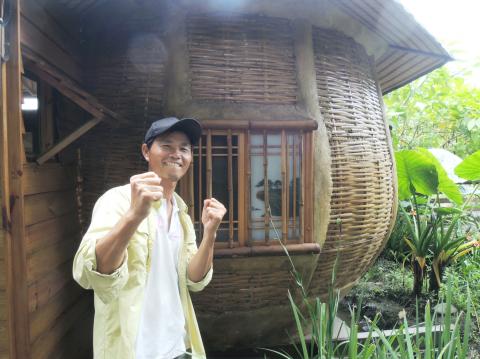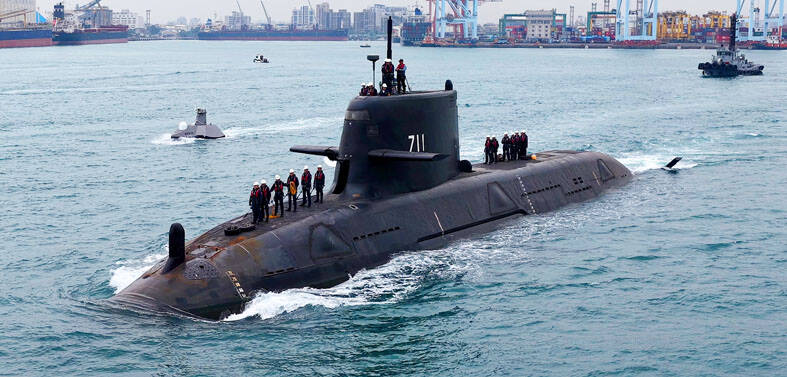Once the manager of a hair salon chain in Taipei, a man in his 40s from Changhua County’s Tianwei Township (田尾) overcame his mid-life crisis by constructing an agriculture-themed hostel that offers backpackers a taste of farm life and a special night in traditional bamboo-built granaries.
Hsueh Ching-chih (薛進智) had lived in Taipei since being discharged from the military 12 years ago.
Hsueh said he started off as a hair washer in a branch of the international hair salon chain Mentor Hair Stylist, but it did not take long before he climbed up the corporate ladder to become the manager of the chain’s 13 branches in Taipei.

Photo: Yan Hung-chun, Taipei Times
Although Hsueh’s success had made him wealthy, it had also left him exhausted as he reached middle age and started experiencing a midlife crisis.
“During that time, I often thought of my parents, who were alone in Tianwei, before I went to sleep at night,” Hsueh said, adding that he felt like he was at a crossroads in life, not knowing whether he should remain in Taipei or return to Changhua.
Hsueh found the answer after he embarked on three cross-country trips, during which he was fascinated by the backpackers’ hostels he had stayed in while traveling through Yilan, Hualien and Taitung counties in eastern Taiwan.
Because there was no such accommodation in Changhua at the time, Hsueh resigned from his job in Taipei in 2011 to return to Tianwei to build the first hostel for backpackers in his hometown.
To match the agricultural theme he chose for his hostel, Hsueh said he converted his family’s farmhouse, which had fallen into disuse over the past two decades, into a wooden social area for his guests.
Unlike most hotel proprietors, Hsueh kept his hostel simple and rustic, surrounding it with Madagascan almond trees his father planted and a paddy field saturated with purple-colored iris flowers.
However, Hsueh was not yet satisfied with his work, saying that “it was still missing some suburban and agricultural elements.”
“Then my mother reminded me that in the early days, most farming families had this granary called a ‘Kuting basket’ (古町畚), so I decided to build two of these things to be the main living areas for my hostel,” Hsueh said.
A “Kuting basket” is a round granary with a thatched roof commonly seen in traditional agricultural areas. Bamboo is used as the framework of the building and for its exterior walls, to which a mixture of mud, rice grains and cow droppings is applied.
Because none of the remaining Kuting baskets in Changhua was well-preserved, Hsueh had to travel to Yunlin County to learn the skills required to construct the traditional barns.
After mastering the basic techniques, Hsueh built a 4 ping (13.2m2) Kuting basket on either side of the wooden social area as the guest rooms.
In addition to local tourists, Hsueh said he has also received backpackers from Japan, the Netherlands, Hong Kong and South Korea since his hostel’s official opening a year ago.
“This generation of young people are adventurous and enjoy traveling on two legs or two wheels. What they are looking for is not a fancy, luxurious hotel, but a place where they can really get a taste of the local life,” Hsueh said.
According to Hsueh, most tourists stayed in his hostel for several days, some traveled to the nearby Shetou Township (社頭) to visit sock factories and taste famous railway boxed meals, while others headed south to Beidou Township (北斗) for Taiwanese meatballs.
“Many of them sent me letters afterward, telling me they had found a new inspiration for their lives by staying in my hostel,” he said.
A traveler from Hong Kong, who identified himself as Hao Tzu (浩子), said he knew about Hsueh’s hostel from a Web site for backpackers and that Hsueh was very nice and charged reasonable rates.

US climber Alex Honnold is to attempt to scale Taipei 101 without a rope and harness in a live Netflix special on Jan. 24, the streaming platform announced on Wednesday. Accounting for the time difference, the two-hour broadcast of Honnold’s climb, called Skyscraper Live, is to air on Jan. 23 in the US, Netflix said in a statement. Honnold, 40, was the first person ever to free solo climb the 900m El Capitan rock formation in Yosemite National Park — a feat that was recorded and later made into the 2018 documentary film Free Solo. Netflix previewed Skyscraper Live in October, after videos

NUMBERS IMBALANCE: More than 4 million Taiwanese have visited China this year, while only about half a million Chinese have visited here Beijing has yet to respond to Taiwan’s requests for negotiation over matters related to the recovery of cross-strait tourism, the Tourism Administration said yesterday. Taiwan’s tourism authority issued the statement after Chinese-language daily the China Times reported yesterday that the government’s policy of banning group tours to China does not stop Taiwanese from visiting the country. As of October, more than 4.2 million had traveled to China this year, exceeding last year. Beijing estimated the number of Taiwanese tourists in China could reach 4.5 million this year. By contrast, only 500,000 Chinese tourists are expected in Taiwan, the report said. The report

Temperatures are forecast to drop steadily as a continental cold air mass moves across Taiwan, with some areas also likely to see heavy rainfall, the Central Weather Administration (CWA) said. From today through early tomorrow, a cold air mass would keep temperatures low across central and northern Taiwan, and the eastern half of Taiwan proper, with isolated brief showers forecast along Keelung’s north coast, Taipei and New Taipei City’s mountainous areas and eastern Taiwan, it said. Lows of 11°C to 15°C are forecast in central and northern Taiwan, Yilan County, and the outlying Kinmen and Lienchiang (Matsu) counties, and 14°C to 17°C

STEERING FAILURE: The first boat of its class is experiencing teething issues as it readies for acceptance by the navy, according to a recent story about rudder failure The Hai Kun (海鯤), the nation’s first locally built submarine, allegedly suffered a total failure of stern hydraulic systems during the second round of sea acceptance trials on June 26, and sailors were forced to manually operate the X-rudder to turn the submarine and return to port, news Web site Mirror Daily reported yesterday. The report said that tugboats following the Hai Kun assisted the submarine in avoiding collisions with other ships due to the X-rudder malfunctioning. At the time of the report, the submarine had completed its trials and was scheduled to begin diving and surfacing tests in shallow areas. The X-rudder,